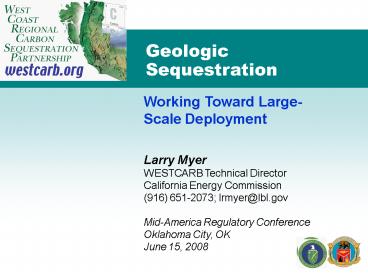WESTCARB Phase I NETL Review Presentation PowerPoint PPT Presentation
1 / 18
Title: WESTCARB Phase I NETL Review Presentation
1
Geologic Sequestration
Working Toward Large-Scale Deployment
Larry Myer WESTCARB Technical Director California
Energy Commission (916) 651-2073
lrmyer_at_lbl.gov Mid-America Regulatory
Conference Oklahoma City, OK June 15, 2008
2
There Is No Silver Bullet for CO2 Stabilization
- Increase efficiency by 25 in buildings and
appliances - Add 100 times current U. S.ethanol production
- Increase fuel economy for 2 billion cars from 30
to 60 mpg - Add 2000 GW-peak PV on 2x106 ha
- Decrease tropical deforestation to zero and
establish 300 Mha of plantations - Create 3500 Sleipners to store CO2 captured
from large point sources
Source Pacala and Socolow, Science, 2004
3
Geologic Storage Involves Capture, Transport and
Underground Injection for Long Term Storage
4
Options for CO2 Capture
- Post-combustion
- Established technology
- Pre-combustion
- Established technology for other applications
- Not demonstrated for power production
- Oxygen combustion
- Not demonstrated for power production
Source S Benson, Stanford
5
Primary Storage Options
- Oil and gas reservoirs
- Storage with Enhanced Oil Recovery (EOR),
Enhanced Gas Recovery (EGR) - Storage only
- Deep, unminable coal beds
- Storage with Enhanced Coal Bed Methane (ECBM)
recovery - Saline formations
- Storage only
6
Geologic Storage Mechanisms
- CO2 is stored in the subsurface by a combination
of physical and chemical processes
W Gunter, ARC
S Benson, Stanford
S Benson, Stanford,
7
CO2 EOR is a Commercial Technology
8
Saline Formation Storage Is Already Under Way
- Statoil injects 1x106 tons per year at Sleipner
- BP to inject 0.8x106 tons per year at In Salah
9
Geologic Sequestration is a Large Scale
Undertaking
- 1,000 MW coal fired plant produces 30,000 t of
CO2 per day for 30 years project size on order
of 110 Km2 - For todays utility emissions, need 180 such
projects
10
National Atlas Documents Sequestration
Opportunities
11
HSE Risks of Geologic Storage
- Impacts of unintended leakage
- Health and safety of workers and general
population - Environmental impacts
- Unwanted intrusion into drinking water
- Earthquakes
- Unwanted intrusion of saline fluids
Tree kill at Mammoth Mountain, CA
http//quake.wr.usgs.gov/prepare/factsheets/CO2/
12
International Consensus on Geologic Storage
Issues Provided by IPCC Report
With appropriate site selection informed by
available subsurface information, a monitoring
program to detect problems, a regulatory system,
and the appropriate use of remediation methods to
stop or control CO2 releases if they arise, the
local health, safety, and environment risks of
geological storage would be comparable to risks
of current activities such as natural gas
storage, EOR, and deep underground disposal of
acid gas.
IPCC, 2005
13
Monitoring will be a Key Element of Geologic
Sequestration Projects
- Sophisticated geophysical technologies, directly
applicable to geologic sequestration, have been
developed in oil and gas industry - Additional approaches should, and are, being
developed - Cost of monitoring over the operational life of a
project using current technology on the order of
0.10/ton CO2
Time-lapse seismic monitoring results from
Sleipner, after Chadwick et al., 2005
14
Risk Decreases Rapidly After Operational Phase
Pressure recovery Secondary trapping
mechanisms Confidence in predictive models
Risk Profile
Injection begins
Injection stops
2 x injection period
3 x injection period
n x injection period
Monitor
Calibrate Validate Models
Calibrate Validate Models
Model
Source S Benson, Stanford
15
Field Tests Provide Regional Knowledge Base
Essential for Commercial Implementation
- Tests demonstrate best sequestration options,
unique technologies and approaches, in region - Tests involve site-specific focus for
- Testing technologies
- Defining costs
- Assessing leakage risks
- Gauging public acceptance
- Exercising regulatory requirements
- Validating monitoring methods
Photos from Frio saline formation CO2 injection
test
16
US DOE Regional Partnership Program (RCSP)
Addresses Implementation Issues
- Opportunities for terrestrial and geologic CO2
storage are being evaluated - Over 350 participating organizations in U. S, and
Canada - Phase I (complete) focus on regional assessments
- Phase II (underway) focus on pilot studies
- Phase III (just starting) large volume geologic
field tests
17
IEA Finds U.S. CO2 Sequestration Program World's
Most Ambitious
Seven large volume tests planned in RCSP Phase
III Program
- Site selection and characterization
- Permitting and NEPA/CEQA compliance
- Well completion and testing
- Infrastructure development
- CO2 procurement and transportation
- Injection operations
- Monitoring activities
- Post-injection monitoring
- Site closure
- Project assessment
Years 1-3
Years 4-7
Years 8-10
18
Getting to Commercial Implementation
- There are no technical show-stoppers, but.
- Storage capacity needs to be refined
- Large scale tests at multiple sites with
different geologies are needed to build knowledge
base for large-scale commercialization - Regulatory and legal ambiguities need to be
cleared (multiple efforts are underway) - Regulatory authority needs definition
- Regulations needed specific to CO2
- Pore space ownership needs to be defined
- A stable carbon market is needed
- Public confidence needs to be gained

